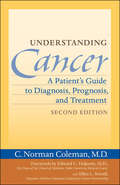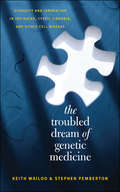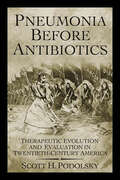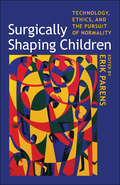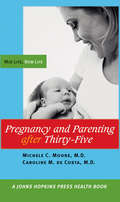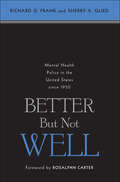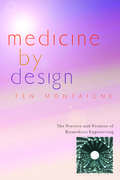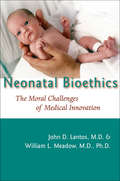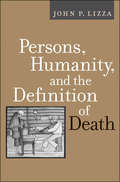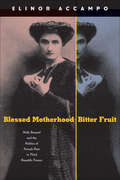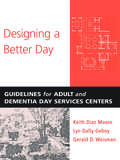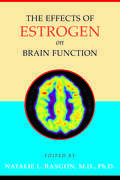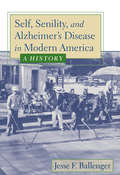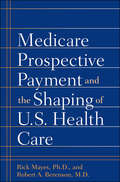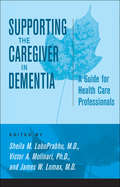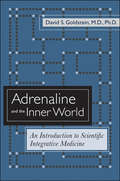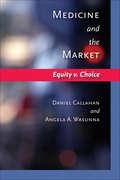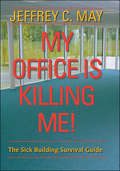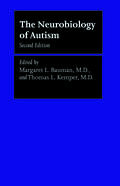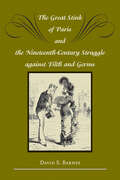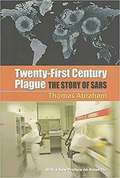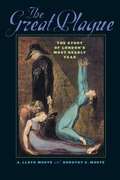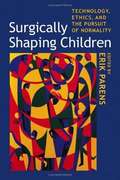- Table View
- List View
Understanding Cancer: A Patient's Guide to Diagnosis, Prognosis, and Treatment
by C. Norman ColemanThe greatest need of anyone with cancer is to understand the disease—its diagnosis, treatment options, and the often devastating experience of having cancer. In Understanding Cancer, Dr. C. Norman Coleman explains how to gather information about treatments and how to interpret that information to make decisions. He helps the person with cancer prepare for visits to doctors and the hospital and to make those visits as productive as possible. He distills the often complex medical terms and concepts underlying the statistics and percentages used to characterize medical conditions. With clear, in-depth discussions of pretreatment staging of disease, the biology of cancer, how successful treatment is defined, and how best to manage one's time, Understanding Cancer helps people with cancer and their families become active participants in the decision-making process.In the second edition of this highly respected guide, Dr. Coleman describes new treatments that target specific types of cancer as well as treatments that are designed for a particular individual. He discusses the era of molecular medicine, including biomarkers, novel imaging, molecular signatures and profiling, and molecular-targeted therapy. Many of these therapies are currently only available through a clinical trial, so Dr. Coleman includes a detailed discussion of what is involved in participating in research trials.Compassionate, accessible, and informative, Understanding Cancer will increase the reader's knowledge of medical concepts and terms so the person with cancer, the family, and the health care team can work together efficiently—and effectively.
The Troubled Dream of Genetic Medicine: Ethnicity and Innovation in Tay-Sachs, Cystic Fibrosis, and Sickle Cell Disease
by Keith Wailoo Stephen PembertonWinner of the History of Science category of the Professional and Scholarly Publishing Awards given by the Association of American PublishersWhy do racial and ethnic controversies become attached, as they often do, to discussions of modern genetics? How do theories about genetic difference become entangled with political debates about cultural and group differences in America? Such issues are a conspicuous part of the histories of three hereditary diseases: Tay-Sachs, commonly identified with Jewish Americans; cystic fibrosis, often labeled a "Caucasian" disease; and sickle cell disease, widely associated with African Americans. In this captivating account, historians Keith Wailoo and Stephen Pemberton reveal how these diseases—fraught with ethnic and racial meanings for many Americans—became objects of biological fascination and crucibles of social debate. Peering behind the headlines of breakthrough treatments and coming cures, they tell a complex story: about different kinds of suffering and faith, about unequal access to the promises and perils of modern medicine, and about how Americans consume innovation and how they come to believe in, or resist, the notion of imminent medical breakthroughs. With Tay-Sachs, cystic fibrosis, and sickle cell disease as a powerful backdrop, the authors provide a glimpse into a diverse America where racial ideologies, cultural politics, and conflicting beliefs about the power of genetics shape disparate health care expectations and experiences.
Pneumonia Before Antibiotics: Therapeutic Evolution and Evaluation in Twentieth-Century America
by Scott H. PodolskyPneumonia—Osler's "Captain of the Men of Death" and still the leading infectious cause of death in the United States—has until now received scant attention from historians. In Pneumonia Before Antibiotics, clinician-historian Scott H. Podolsky uses pneumonia's enduring prevalence and its centrality to the medical profession's therapeutic self-identity to examine the evolution of therapeutics in twentieth-century America. Focusing largely on the treatment of pneumonia in first half of the century with type-specific serotherapy, Podolsky provides insight into the rise and clinical evaluation of therapeutic "specifics," the contested domains of private practice and public health, and-as the treatment of pneumonia made the transition from serotherapy to chemotherapy and antibiotics—the tempo and mode of therapeutic change itself. Type-specific serotherapy, founded on the tenets of applied immunology, justified by controlled clinical trials, and grounded in a novel public ethos, was deemed revolutionary when it emerged to replace supportive therapeutics. With the advent of the even more revolutionary sulfa drugs and antibiotics, pneumonia ceased to be a public health concern and became instead an illness treated in individual patients by individual physicians. Podolsky describes the new therapeutics and the scientists and practitioners who developed and debated them. He finds that, rather than representing a barren era in anticipation of some unknown transformation to come, the first decades of the twentieth-century shaped the use of, and reliance upon, the therapeutic specific throughout the century and beyond. This intriguing study will interest historians of medicine and science, policymakers, and clinicians alike.
Pneumonia Before Antibiotics: Therapeutic Evolution and Evaluation in Twentieth-Century America
by Scott H. Podolsky“Uses [pneumonia] as a vehicle for examining the evolution of therapeutics in America between the ‘Golden Age of Microbiology’ and the ‘Age of Antibiotics.’”—IsisFocusing largely on the treatment of pneumonia in first half of the century with type-specific serotherapy, clinician-historian Scott H. Podolsky provides insight into the rise and clinical evaluation of therapeutic “specifics,” the contested domains of private practice and public health, and—as the treatment of pneumonia made the transition from serotherapy to chemotherapy and antibiotics—the tempo and mode of therapeutic change itself. Type-specific serotherapy, founded on the tenets of applied immunology, justified by controlled clinical trials, and grounded in a novel public ethos, was deemed revolutionary when it emerged to replace supportive therapeutics. With the advent of the even more revolutionary sulfa drugs and antibiotics, pneumonia ceased to be a public health concern and became instead an illness treated in individual patients by individual physicians.Podolsky describes the new therapeutics and the scientists and practitioners who developed and debated them. He finds that, rather than representing a barren era in anticipation of some unknown transformation to come, the first decades of the twentieth-century shaped the use of, and reliance upon, the therapeutic specific throughout the century and beyond. This intriguing study will interest historians of medicine and science, policymakers, and clinicians alike.“Podolsky’s scholarship is awesome, and his grasp of the philosophical and sociologic context of the issues considered make this an important work.” —New England Journal of Medicine“This thoroughly documented, carefully written book is a landmark analysis . . . It should be read by everyone who is involved in research and therapeutic development.” —JAMA
Surgically Shaping Children: Technology, Ethics, and the Pursuit of Normality
by Erik ParsensWinner of an Honorable Mention in the Clinical Medicine category of the Professional and Scholarly Publishing Awards given by the Association of American PublishersAt a time when medical technologies make it ever easier to enhance our minds and bodies, a debate has arisen about whether such efforts promote a process of "normalization," which makes it ever harder to tolerate the natural anatomical differences among us. The debate becomes especially complicated when it addresses the surgical alteration, or "shaping," of children. This volume explores the ethical and social issues raised by the recent proliferation of surgeries designed to make children born with physical differences look more normal.Using three cases—surgeries to eliminate craniofacial abnormalities such as cleft lip and palate, surgeries to correct ambiguous genitalia, and surgeries to lengthen the limbs of children born with dwarfism—the contributors consider the tensions parents experience when making such life-altering decisions on behalf of or with their children.The essays in this volume offer in-depth examinations of the significance and limits of surgical alteration through personal narratives, theoretical reflections, and concrete suggestions about how to improve the decision-making process. Written from the perspectives of affected children and their parents, health care providers, and leading scholars in philosophy, sociology, history, law, and medicine, this collection provides an integrated and comprehensive foundation from which to consider a complex and controversial issue. It takes the reader on a journey from reflections on the particulars of current medical practices to reflections on one of the deepest and most complex of human desires: the desire for normality.ContributorsPriscilla Alderson, Adrienne Asch, Cassandra Aspinall, Alice Domurat Dreger, James C. Edwards, Todd C. Edwards, Ellen K. Feder, Arthur W. Frank, Lisa Abelow Hedley, Eva Fedder Kittay, Hilde Lindemann, Jeffery L. Marsh, Paul Steven Miller, Sherri G. Morris, Wendy E. Mouradian, Donald L. Patrick, Nichola Rumsey, Emily Sullivan Sanford, Tari D. Topolski
Pregnancy and Parenting after Thirty-Five: Mid Life, New Life (A Johns Hopkins Press Health Book)
by Michele C. Moore Caroline M. de CostaMore and more women are having babies after the age of thirty-five and experiencing the joy of motherhood. But mothers-to-be in this age group sometimes face unique medical, emotional, and social challenges. Conception may be difficult and the risk of miscarriage during early pregnancy is higher, as is the potential for complications such as hypertension and diabetes. And having a child later in life can also be surprisingly disruptive to well-established domestic routines and carefully cultivated careers. Michele Moore and Caroline de Costa—two physicians who have been down this road themselves—offer reliable medical expertise and personal reassurance to women tackling these challenges. Pregnancy and Parenting after Thirty-Five covers a broad range of issues for mothers in mid life, from the possibility of Cesarean section to the awkwardness of being the oldest mom at PTA meetings to the joy of holding your infant in your arms. Incorporating the stories of real women who have gone through mid-life pregnancy, Moore and de Costa have created a valuable resource that will help other women do so realistically and with confidence. One of the few books devoted to prospective mothers over thirty-five, this one also includes information on surrogacy, adoption, and the first few months of being a new mother.
Better But Not Well: Mental Health Policy in the United States since 1950
by Richard G. Frank Sherry A. GliedThe past half-century has been marked by major changes in the treatment of mental illness: important advances in understanding mental illnesses, increases in spending on mental health care and support of people with mental illnesses, and the availability of new medications that are easier for the patient to tolerate. Although these changes have made things better for those who have mental illness, they are not quite enough. In Better But Not Well, Richard G. Frank and Sherry A. Glied examine the well-being of people with mental illness in the United States over the past fifty years, addressing issues such as economics, treatment, standards of living, rights, and stigma. Marshaling a range of new empirical evidence, they first argue that people with mental illness—severe and persistent disorders as well as less serious mental health conditions—are faring better today than in the past. Improvements have come about for unheralded and unexpected reasons. Rather than being a result of more effective mental health treatments, progress has come from the growth of private health insurance and of mainstream social programs—such as Medicaid, Supplemental Security Income, housing vouchers, and food stamps—and the development of new treatments that are easier for patients to tolerate and for physicians to manage. The authors remind us that, despite the progress that has been made, this disadvantaged group remains worse off than most others in society. The "mainstreaming" of persons with mental illness has left a policy void, where governmental institutions responsible for meeting the needs of mental health patients lack resources and programmatic authority. To fill this void, Frank and Glied suggest that institutional resources be applied systematically and routinely to examine and address how federal and state programs affect the well-being of people with mental illness.
Medicine by Design: The Practice and Promise of Biomedical Engineering
by Fen MontaigneA heart that once beat erratically has regained its natural rhythm. A woman paralyzed by an automobile accident is now able to resume her favorite hobby. Physicians using a robotic surgeon named da Vinci perform lifesaving operations. These are some of the feats of biomedical engineering, one of the fastest-moving areas in medicine. In this exhilarating book, award-winning writer Fen Montaigne journeys through this little-known world, sharing the stories of ordinary people who have been transformed by technology. From the almost commonplace pacemaker to the latest generation of artificial hearts, Montaigne tells the stories of pioneering patients, engineers, and surgeons. Taking the reader behind the scenes of a dozen of America's leading centers of biomedical engineering, Montaigne recounts the field's history while describing cutting-edge work in medical imaging, orthopedics, cardiovascular care, neurological therapies, and genetics. Through the stories of patients whose lives have been saved and improved by biomedical devices, Montaigne reveals the marriage of medicine and engineering to be one of society's greatest advances.
Neonatal Bioethics: The Moral Challenges of Medical Innovation (Bioethics)
by John D. Lantos William L. MeadowNeonatal intensive care has been one of the most morally controversial areas of medicine during the past thirty years. This study examines the interconnected development of four key aspects of neonatal intensive care: medical advances, ethical analysis, legal scrutiny, and econometric evaluation.The authors assert that a dramatic shift in societal attitudes toward newborns and their medical care was a stimulus for and then a result of developments in the medical care of newborns. They divide their analysis into three eras of neonatal intensive care. The first, characterized by the rapid advance of medical technology from the late 1960s to the Baby Doe case of 1982, established neonatal care as a legitimate specialty of medical care, separate from the rest of pediatrics and medicine. During this era, legal scholars and moral philosophers debated the relative importance of parental autonomy, clinical prognosis, and children's rights. The second era, beginning with the Baby Doe case (a legal battle that spurred legislation mandating that infants with debilitating birth defects be treated unless the attending physician deems efforts to prolong life "futile"), stimulated efforts to establish a consistent federal standard on neonatal care decisions and raised important moral questions concerning the meaning of "futility" and of "inhumane" treatment. In the third era, a consistent set of decision-making criteria and policies was established. These policies were the result of the synergy and harmonization of newly agreed upon ethical principles and newly discovered epidemiological characteristics of neonatal care.Tracing the field's recent history, notable advances, and considerable challenges yet to be faced, the authors present neonatal bioethics as a paradigm of complex conversation among physicians, philosophers, policy makers, judges, and legislators which has led to responsible societal oversight of a controversial medical innovation.
Persons, Humanity, and the Definition of Death (Bioethics)
by John P. LizzaIn this riveting and timely work, John P. Lizza presents the first comprehensive analysis of personhood and humanity in the context of defining death. Rejecting the common assumption that human or personal death is simply a biological phenomenon for biologists or physicians to define, Lizza argues that the definition of death is also a matter for metaphysical reflection, moral choice, and cultural acceptance. Lizza maintains that defining death remains problematic because basic ontological, ethical, and cultural issues have never been adequately addressed. Advances in life-sustaining technology and organ transplantation have led to revision of the legal definition of death. It is generally accepted that death occurs when all functions of the brain have ceased. However, legal and clinical cases involving postmortem pregnancy, individuals in permanent vegetative state, those with anencephaly, and those with severe dementia challenge the neurological criteria. Is "brain death" really death? Should the neurological criteria be expanded to include individuals in permanent vegetative state, with anencephaly, and those with severe dementia? What metaphysical, ethical, and cultural considerations are relevant to answering such questions?Although Lizza accepts a pluralistic approach to the legal definition of death, he proposes a nonreductive, substantive view in which persons are understood as "constituted by" human organisms. This view, he argues, provides the best account of human nature as biological, moral, and cultural and supports a consciousness-related formulation of death. Through an analysis of legal and clinical cases and a discussion of alternative concepts of personhood, Lizza casts greater light on the underlying themes of a complex debate.
Blessed Motherhood, Bitter Fruit: Nelly Roussel and the Politics of Female Pain in Third Republic France
by Elinor AccampoNelly Roussel (1878–1922)—the first feminist spokeswoman for birth control in Europe—challenged both the men of early twentieth-century France, who sought to preserve the status quo, and the women who aimed to change it. She delivered her messages through public lectures, journalism, and theater, dazzling audiences with her beauty, intelligence, and disarming wit. She did so within the context of a national depopulation crisis caused by the confluence of low birth rates, the rise of international tensions, and the tragedy of the First World War. While her support spread across social classes, strong political resistance to her message revealed deeply conservative precepts about gender which were grounded in French identity itself. In this thoughtful and provocative study, Elinor Accampo follows Roussel's life from her youth, marriage, speaking career, motherhood, and political activism to her decline and death from tuberculosis in the years following World War I. She tells the story of a woman whose life and work spanned a historical moment when womanhood was being redefined by the acceptance of a woman's sexuality as distinct from her biological, reproductive role—a development that is still causing controversy today.
Designing a Better Day: Guidelines for Adult and Dementia Day Services Centers
by Keith Diaz Moore Lyn Dally Geboy Gerald D. WeismanWinner of the 2007 Polsky Prize given by the ASID FoundationAs the U.S. population ages, adult day services have become an integral component in the continuum of care for elderly people. Providing a variety of social and medical services for cognitively or physically impaired elderly people who otherwise might reside in institutions, these facilities can be found in a variety of building types, from purpose-built facilities to the proverbial church basement. They also vary widely in their philosophies, case mix, funding mechanisms, and services. In this interdisciplinary study, Keith Diaz Moore, Lyn Dally Geboy, and Gerald D. Weisman offer guidance for planning and designing good-quality adult day services centers. They encourage architects, caregivers, and staff members to think beyond the building, organizational mission, and staffing structure to conceive of the place that emerges as an interrelated system of people, programming, and physical setting. Through case studies, thoughtful explanations, and well-crafted illustrations, Designing a Better Day provides caregivers, architects, and administrators tools with which they can make qualitative changes for participants and their families. Organized into three parts—creating awareness, increasing understanding, and taking action—this book will be a key resource for professionals involved in creating and maintaining effective adult day services centers.
The Effects of Estrogen on Brain Function
by Natalie L RasgonThis timely volume reviews current data on the effects of estrogen on the central nervous system, highlighting clinical aspects of this topic. Experts from the fields of psychiatry, pharmacology, neurology, and geriatrics collaborate to clarify the known risks and benefits of hormone therapy and explore questions that remain to be elucidated.Among the topics discussed:" Preclinical data on estrogen's effects on cognitive performance" The short-lived effects of hormone replacement therapy on cognitive function" Structural and functional brain imaging data regardingestrogen's effects on the central nervous system " Preclinical efforts to develop effective NeuroSERMs for the brain " The effects of estrogen on moodCiting the ongoing confusion over the risks and benefits of estrogen therapy, the contributors emphasize the need for additional research on medication, doses, preparations, methods of administration, alternative therapies, and supplements. This volume educates researchers, clinicians, and students on the current knowledge—including the effects of estrogen on mood, cognition, and brain metabolism—and provides guidelines for clinical practice and future research.Contributors: Roberta Diaz Brinton, Ph.D., University of Southern California; Cheri L. Geist, B.A., David Geffen School of Medicine, University of California at Los Angeles; Robert B. Gibbs, Ph.D., University of Pittsburgh School of Pharmacy; Eva Hogervorst, Ph.D., University of Loughborough and University of Oxford; Pauline M. Maki, Ph.D., Neuropsychiatric Institute, University of Illinois–Chicago; Peter J. Schmidt, M.D., National Institute of Mental Health; Daniel H. S. Silverman, M.D., Ph.D., David Geffen School of Medicine, University of California at Los Angeles; Katherine E. Williams, M.D., Stanford University School of Medicine; Kristine Yaffe, M.D., University of California, San Francisco, and San Francisco VA Medical Center; Laurel N. Zappert, B.A., Stanford University School of Medicine; Liqin Zhao, Ph.D., University of Southern California
Self, Senility, and Alzheimer's Disease in Modern America: A History
by Jesse F. BallengerHistorian Jesse F. Ballenger traces the emergence of senility as a cultural category from the late nineteenth century to the 1980s, a period in which Alzheimer's disease became increasingly associated with the terrifying prospect of losing one's self. Changes in American society and culture have complicated the notion of selfhood, Ballenger finds. No longer an ascribed status, selfhood must be carefully and willfully constructed. Thus, losing one's ability to sustain a coherent self-narrative is considered one of life's most dreadful losses. As Ballenger writes "senility haunts the landscape of the self-made man." Stereotypes of senility and Alzheimer's disease are related to anxiety about the coherence, stability, and agency of the self—stereotypes that are transforming perceptions of old age in modern America. Drawing on scientific, clinical, policy, and popular discourses on aging and dementia, Ballenger explores early twentieth-century concepts of aging and the emergence of gerontology to understand and distinguish normal aging from disease. In addition, he examines American psychiatry's approaches to the treatment of senility and scientific attempts to understand the brain pathology of dementia.Ballenger's work contributes to our understanding of the emergence and significance of dementia as a major health issue.
Medicare Prospective Payment and the Shaping of U.S. Health Care
by Rick Mayes Robert A. BerensonThis is the definitive work on Medicare’s prospective payment system (PPS), which had its origins in the 1972 Social Security Amendments, was first applied to hospitals in 1983, and came to fruition with the Balanced Budget Act of 1997. Here, Rick Mayes and Robert A. Berenson, M.D., explain how Medicare’s innovative payment system triggered shifts in power away from the providers (hospitals and doctors) to the payers (government insurers and employers) and how providers have responded to encroachments on their professional and financial autonomy. They conclude with a discussion of the problems with the Medicare Modernization Act of 2003 and offer prescriptions for how policy makers can use Medicare payment policy to drive improvements in the U.S. health care system.Mayes and Berenson draw from interviews with more than sixty-five major policy makers—including former Treasury secretary Robert Rubin, U.S. Representatives Pete Stark and Henry Waxman, former White House chief of staff Leon Panetta, and former administrators of the Health Care Financing Administration Gail Wilensky, Bruce Vladeck, Nancy-Ann DeParle, and Tom Scully—to explore how this payment system worked and its significant effects on the U.S. medical landscape in the past twenty years. They argue that, although managed care was an important agent of change in the 1990s, the private sector has not been the major health care innovator in the United States; rather, Medicare’s transition to PPS both initiated and repeatedly intensified the economic restructuring of the U.S. health care system.
Supporting the Caregiver in Dementia: A Guide for Health Care Professionals
by Sheila M. LoboprabhuDementia is one of the greatest challenges facing seniors and their caregivers around the globe. Developed by experts in both research and practice, this guide for mental health clinicians explores the experience of caregiving in dementia, discussing the latest research developments and sharing clinical pearls of wisdom that can easily be translated to daily practice.The contributors explore the history of caregiving and then examine the current demographics of caregivers for persons with dementia. They discuss who provides care, the settings in which it is delivered, and the rewards and burdens of caregiving. They place special emphasis on understanding the psychological needs of both the person with dementia and the caregiver, as well as interpersonal bonds, spiritual dimensions, and reactions to grief and loss. Using a multidisciplinary approach to treatment for caregivers, this book addresses the role of pharmacotherapy, individual and family interventions, and social supports. Finally, the authors reflect on societal issues such as health care policies, ethnic elders, and ethics.This volume offers health professionals insights into the daily lives of caregivers, along with tools to provide their patients with the support they need.
Adrenaline and the Inner World: An Introduction to Scientific Integrative Medicine
by David S. GoldsteinThis accessible work is the first in more than seventy-five years to discuss the many roles of adrenaline in regulating the "inner world" of the body. David S. Goldstein, an international authority and award-winning teacher, introduces new concepts concerning the nature of stress and distress across the body's regulatory systems. Discussing how the body's stress systems are coordinated, and how stress, by means of adrenaline, may affect the development, manifestations, and outcomes of chronic diseases, Goldstein challenges researchers and clinicians to use scientific integrative medicine to develop new ways to treat, prevent, and palliate disease. Goldstein explains why a former attorney general with Parkinson disease has a tendency to faint, why young astronauts in excellent physical shape cannot stand up when reexposed to Earth's gravity, why professional football players can collapse and die of heat shock during summer training camp, and why baseball players spit so much. Adrenaline and the Inner World is designed to supplement academic coursework in psychology, psychiatry, endocrinology, cardiology, complementary and alternative medicine, physiology, and biochemistry. It includes an extensive glossary.
Medicine and the Market: Equity v. Choice (Bioethics)
by Daniel Callahan Angela A. WasunnaOutstanding Academic Title for 2007, Choice MagazineMuch has been written about medicine and the market in recent years. This book is the first to include an assessment of market influence in both developed and developing countries, and among the very few that have tried to evaluate the actual health and economic impact of market theory and practices in a wide range of national settings.Tracing the path that market practices have taken from Adam Smith in the eighteenth century into twenty-first-century health care, Daniel Callahan and Angela A. Wasunna add a fresh dimension: they compare the different approaches taken in the market debate by health care economists, conservative market advocates, and liberal supporters of single-payer or government-regulated systems. In addition to laying out the market-versus-government struggle around the world—from Canada and the United States to Western Europe, Latin America, and many African and Asian countries—they assess the leading market practices, such as competition, physician incentives, and co-payments, for their economic and health efficacy to determine whether they work as advertised. This timely and necessary book engages new dimensions of a development that has urgent consequences for the delivery of health care worldwide.
My Office Is Killing Me!: The Sick Building Survival Guide
by Jeffrey C. MayBacteria and mold may lurk undetected in carpets or in the heating or cooling system of your office or school. When inhaled, the by-products of these organisms can cause allergy and asthma symptoms. Chemical vapors emitted by office furniture and equipment may also foul the air we breathe indoors, causing headaches, eye irritation, or other symptoms. Here the author of the best-selling My House Is Killing Me! and co-author of The Mold Survival Guide turns his attention to indoor air quality in public buildings. Blending his extensive professional experience with scientific explanations, May helps us see these buildings through the eyes of a building scientist, microscopist, and organic chemist. He offers a step-by-step approach to identifying, controlling, and often eliminating the sources of indoor air pollutants and allergens. Whether it's a case of mold in an elementary school or inadequate ventilation in a high-rise office building, this valuable guide can help people cope when the air they breathe indoors is making them sick.
The Neurobiology of Autism (The Johns Hopkins Series in Psychiatry and Neuroscience)
by Margaret L. BaumanIn the decade since the first edition of The Neurobiology of Autism was published, research has revealed valuable new information about the nature and origins of autism, including genetics and abnormalities in such neurotransmitters as acetylcholine and serotonin. For this long-anticipated new edition, neurologists Margaret L. Bauman and Thomas L. Kemper bring together leading researchers and clinicians to present the most current scientific knowledge and theories about autism. The contributors cover genetics, imaging studies, physiology, neuroanatomy and neurochemistry, immunology, brain function, the epidemiology of the disease, and related disorders. Thoroughly updated, The Neurobiology of Autism remains the best single-volume work on the wide array of research being conducted into the causes, characteristics, and treatment of autism.Contributors: George M. Anderson, Yale Child Study Center; Tara L. Arndt, University of Rochester Medical Center (URMC); Trang Au, University of Massachusetts Medical School (UMMC); Jocelyne Bachevalier, University of Texas Health Science Center; Irina N. Bespalova, Seaver Autism Research Center, Mt. Sinai School of Medicine (SARC); Gene J. Blatt, Boston University School of Medicine (BUSM); Susan E. Bryson, IWK Health Centre–Dalhousie University; Timothy M. Buie, Massachusetts General Hospital (MGH); Joseph D. Buxbaum, SARC; Kathryn M. Carbone, The Johns Hopkins University School of Medicine (JHUSM); Diane C. Chugani, Wayne State University; Daniel F. Connor, UMMC; Edwin H. Cook, Jr., University of Chicago; S. Hossein Fatemi, University of Minnesota Medical School; Susan E. Folstein, Tufts University School of Medicine; Eric Fombonne, McGill University; Randi Jenssen Hagerman, UC Davis Medical Center; Elizabeth Petri Henske, Fox Chase Cancer Center, Philadelphia; Jeannette J. A. Holden, Queen's University; Ronald J. Killiany, BUSM; Omanand Koul, UMMC; Mandy Lee, Newcastle General Hospital, U.K.; Xudong Liu, Queen's University; Tara L. Moore, BUSM; Mark B. Moss, BUSM; Karin B. Nelson, National Institute of Neurological Disorders and Stroke; Phillip G. Nelson, National Institute of Child Health and Human Development; Elaine Perry, Newcastle General Hospital; Jonathan Pevsner, JHUSM; Mikhail V. Pletnikov, JHUSM; Stephen W. Porges, University of Illinois at Chicago; Lucio Rehbein, Universidad de la Frontera, Chile; Jennifer Reichert, SARC; Patricia M. Rodier, URMC; Beth Rosen-Sheidley, MGH; Susan L. Smalley, UCLA Neuropsychiatric Research Institute; Ronald J. Steingard, UMMC; Helen Tager-Flusberg, BUSM; Gary L. Wenk, University of Arizona; Andrew W. Zimmerman, JHUSM
The Great Stink of Paris and the Nineteenth-Century Struggle against Filth and Germs
by David S. BarnesExplores the scientific and social factors that continue to influence the public's lingering uncertainty over how disease can—and cannot—be spread.Late in the summer of 1880, a wave of odors enveloped large portions of Paris. As the stench lingered, outraged residents feared that the foul air would breed an epidemic. Fifteen years later—when the City of Light was in the grips of another Great Stink—the public conversation about health and disease had changed dramatically. Parisians held their noses and protested, but this time few feared that the odors would spread disease. Historian David S. Barnes examines the birth of a new microbe-centered science of public health during the 1880s and 1890s, when the germ theory of disease burst into public consciousness. Tracing a series of developments in French science, medicine, politics, and culture, Barnes reveals how the science and practice of public health changed during the heyday of the Bacteriological Revolution.Despite its many innovations, however, the new science of germs did not entirely sweep away the older "sanitarian" view of public health. The longstanding conviction that disease could be traced to filthy people, places, and substances remained strong, even as it was translated into the language of bacteriology. Ultimately, the attitudes of physicians and the French public were shaped by political struggles between republicans and the clergy, by aggressive efforts to educate and "civilize" the peasantry, and by long-term shifts in the public's ability to tolerate the odor of bodily substances.
The Great Stink of Paris and the Nineteenth-Century Struggle against Filth and Germs
by David S. BarnesThe scientific and social history surrounding the 1880 incident of a foul odor in Paris and the development of public health culture that followed.Late in the summer of 1880, a wave of odors enveloped large portions of Paris. As the stench lingered, outraged residents feared that the foul air would breed an epidemic. Fifteen years later—when the City of Light was in the grips of another Great Stink—the public conversation about health and disease had changed dramatically. Parisians held their noses and protested, but this time few feared that the odors would spread disease.Historian David S. Barnes examines the birth of a new microbe-centered science of public health during the 1880s and 1890s, when the germ theory of disease burst into public consciousness. Tracing a series of developments in French science, medicine, politics, and culture, Barnes reveals how the science and practice of public health changed during the heyday of the Bacteriological Revolution.Despite its many innovations, however, the new science of germs did not entirely sweep away the older “sanitarian” view of public health. The longstanding conviction that disease could be traced to filthy people, places, and substances remained strong, even as it was translated into the language of bacteriology. Ultimately, the attitudes of physicians and the French public were shaped by political struggles between republicans and the clergy, by aggressive efforts to educate and “civilize” the peasantry, and by long-term shifts in the public’s ability to tolerate the odor of bodily substances.“A well-developed study in medically related social history, it tells an intriguing tale and prompts us to ask how our own cultural contexts affect our views and actions regarding environmental and infectious scourges here and now.” —New England Journal of Medicine“Both a captivating story and a sophisticated historical study. Kudos to Barnes for this valuable and insightful book that both physicians and historians will enjoy.” —Journal of the American Medical Association
Twenty-First Century Plague: The Story of SARS
by Thomas AbrahamIn the autumn of 2002 in southern China, a previously unknown virus jumped the species barrier from animal to man and sparked the first global epidemic of the new century. The disease sped along the air routes of a globalized world, spreading within months to thirty-one countries on every continent. <p><p> Before it was reined in by a remarkable international scientific effort, the SARS virus demonstrated human society's vulnerability to disease. New infectious diseases like SARS have been emerging at an alarming rate over the past few decades. There is every indication the world will continue to face new viral diseases, some of them much more lethal and contagious than SARS. <p><p> This book traces the emergence of SARS, in the process examining the global politics and economics of disease. It provides the first behind-the-scenes account of how the global battle against SARS was fought and the incredible research efforts that finally led to identification of the virus. <p><p> Drawing on unprecedented access to scientists, doctors, and recovered patients, Thomas Abraham recounts the pressures and heartbreaks suffered by brave researchers who battled the clock to solve the SARS puzzle―even as colleagues and friends succumbed to the disease.
The Great Plague: The Story of London's Most Deadly Year
by A. Lloyd Moote Dorothy C. MooteUnderscoring the human dimensions of the epidemic, historian A. Lloyd Moote and microbiologist Dorothy C. Moote provide an engrossing and deeply informed account of 1665, a cataclysmic plague year in London.
Surgically Shaping Children: Technology, Ethics, and the Pursuit of Normality
by Erik ParensAt a time when medical technologies make it ever easier to enhance our minds and bodies, a debate has arisen about whether such efforts promote a process of "normalization," which makes it ever harder to tolerate the natural anatomical differences among us. The debate becomes especially complicated when it addresses the surgical alteration, or "shaping," of children. This volume explores the ethical and social issues raised by the recent proliferation of surgeries designed to make children born with physical differences look more normal. Using three cases—surgeries to eliminate craniofacial abnormalities such as cleft lip and palate, surgeries to correct ambiguous genitalia, and surgeries to lengthen the limbs of children born with dwarfism—the contributors consider the tensions parents experience when making such life-altering decisions on behalf of or with their children. The essays in this volume offer in-depth examinations of the significance and limits of surgical alteration through personal narratives, theoretical reflections, and concrete suggestions about how to improve the decision-making process. Written from the perspectives of affected children and their parents, health care providers, and leading scholars in philosophy, sociology, history, law, and medicine, this collection provides an integrated and comprehensive foundation from which to consider a complex and controversial issue. It takes the reader on a journey from reflections on the particulars of current medical practices to reflections on one of the deepest and most complex of human desires: the desire for normality.
